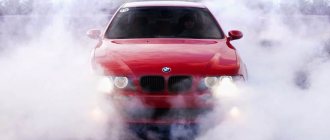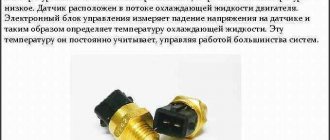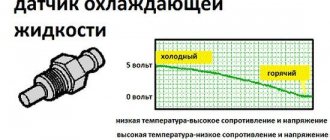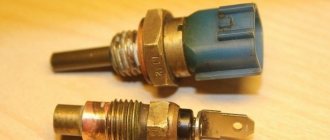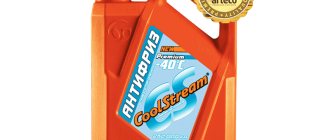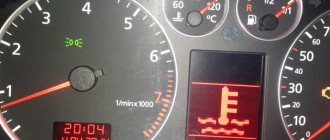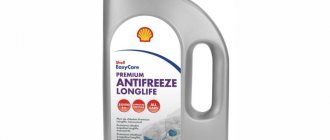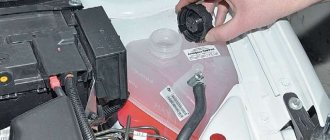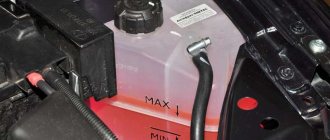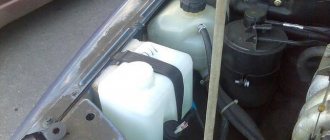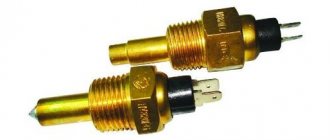What antifreeze consumption is considered normal?
If the antifreeze consumption
does not exceed 100 milliliters in 1 year or 40,000 kilometers, then for most cars this is
normal
.
This loss of antifreeze
is more likely a consequence of coolant evaporation than a leak in the cooling system.
Interesting materials:
How do I know when I registered on Instagram? How to find out when an Instagram user was online? How to find out when was the last time you logged into Instagram? How to find out when you created a page on Instagram? How to find out when an Instagram account was created? How do I find out who I sent a follow request to on Instagram? How do I find out who I sent a request to on Instagram? How do I find out who I liked on Instagram? How do I find out who I liked on Insta? How to find out who has been followed on Instagram?
Where and how to buy engine cooling fluid
There are several basic rules that will help the buyer not to run into counterfeit antifreeze.
- You should not buy expensive “anti-freeze” from famous brands in dubious places.
- Do not buy cheap antifreeze from unknown manufacturers.
- It is better to buy goods at branded gas stations that value their reputation, or from large, reputable sellers.
- Pay attention to the date of manufacture and purchase a more “fresh” product.
- Require certificate .
- Check the tightness of the container. The canister with fresh, high-quality antifreeze is securely sealed and does not release air when squeezed.
How to check the acid-base balance of purchased antifreeze
You can use litmus paper . To do this, dip the test strip into the coolant and wait for the result. Then compare the colored strip with a special color scale that indicates the pH level .
But if such a scale is not at hand, you can determine it by eye. The pink color acquired by litmus paper will indicate the presence of a large amount of acid in the antifreeze (pH in the range from 1 to 5) . Blue color , on the contrary, demonstrates an excess of alkali (more than 10). These indicators indicate a fake, therefore this product should not be used. The optimal pH level in antifreeze should be from 7 to 9. In such a liquid, litmus paper will turn green and fix a quality product.
You can also test the coolant with plain soda . If the purchased antifreeze is a fake and contains acid, then a small amount of soda will provoke a short-term reaction in it in the form of gas release and the formation of a precipitate. The use of such antifreeze should be abandoned .
Probable leak locations
Where can antifreeze go? It is still a liquid, so it can evaporate when heated. To make evaporation less intense, the tank or radiator is tightly closed with a lid. But complete blockage is also not allowed, so there are bypass valves in the lid.
They are needed to relieve pressure in the system if it has risen above the critical norm. It is through this valve that antifreeze evaporates, especially in the summer season. It is very hot in the summer, and if you drive in a traffic jam, the cooling system will not have time to fully remove heat from the engine; it will operate at an elevated temperature. In this case, the antifreeze heats up more than normal, part of it goes into a gaseous state (steam), increasing the pressure in the system, and when the pressure rises above normal, the steam will be released through the valve.
Antifreeze may also leak due to a leak in the system or a crack in one of the rubber pipes. Because of this, the coolant will simply leak out through a leak or crack. In this case, it is very easy to detect a leak - by drips on the pipes and traces of liquid on the asphalt under the car while parked.
The most unpleasant leak is due to a breakdown of the cylinder head gasket (cylinder head). As a result of the breakdown, the cooling system channel is connected to the cylinder, or the crack leads outward. It is very dangerous if a breakdown connects the channel to the cylinder. Not only will the liquid “fly out into the pipe” in the literal sense, but if the repair is untimely, a “water hammer” may occur due to the large amount of antifreeze in the cylinder, and this is already fraught with serious problems, since as a result of this effect the destruction of the piston is possible, connecting rod bend.
It is noteworthy that a cylinder head gasket failure is usually a consequence of engine overheating due to insufficient antifreeze.
Consequences of a cylinder head gasket failure
How to determine what is flooded?
It will not be possible to check and recognize using color what is in the car. Antifreeze is always colored blue. But modern antifreezes are also available in blue.
If you don’t know what’s in the car, you can determine the type of consumables based on several factors:
- Smell and taste. Antifreezes are usually odorless, and if you touch the liquid, it will be more oily, unlike traditional antifreeze.
- Determining the type of liquid can be done by diagnosing the compatibility of the refrigerant with ordinary water. You need to take a little substance from the expansion tank and mix it with tap water in a 1:1 ratio. Afterwards, the container with the refrigerant is placed in the freezer for about one hour. If, as a result, the liquids separate, the mixed substance becomes cloudy and sediment forms at the bottom, then you use Antifreeze. If high-quality antifreeze is poured into the cooling system of your car, then such problems will not arise.
- Another factor is resistance to negative low temperatures. Pour a small amount of refrigerant into a separate bottle and place it in the freezer. When using Antifreeze, the liquid will quickly freeze, but if a good refrigerant is added, this will not happen.
- Using a hydrometer, you can diagnose the density indicator of a substance. The test should be carried out at an air temperature of 20 degrees. With this condition, the refrigerant density parameter should be about 1.073-1.079 g/cm3. If so, then you are using antifreeze.
For diagnosis, you can resort to the old “old-fashioned” method:
- You will need a plate or other metal device. You will also need a rubber product, for example, a piece of hose from the cooling system.
- Take some fluid from the reservoir under the hood of your car. You need to pour it into a jar or bottle, where you should also place a plate and a piece of hose.
- After 20 minutes, look at the result. Russian-made consumables create a protective layer on all components of the cooling system. Accordingly, you will see a barely noticeable film on both the plate and the piece of hose. If the metal is corroded, and a film has formed only where rust is present, then you use antifreeze. Remove the products from the container and check them by touch.
Density check
To determine this indicator, you do not need to have special skills; every car owner, even a beginner, can handle the operation. The procedure is carried out using a special device - a hydrometer. You can buy it at any construction or hardware store.
The hydrometer looks like a glass flask with a trunk necessary for insertion into the solution at one end, and with a special rubber bulb at the other. The device contains a float with a scale. As soon as liquid gets inside the devices, the float begins to float, thereby showing density values.
It is important to know that most devices have temperature gradations, so they are considered the best application option to check the density of antifreeze most fully. By filling the device with coolant, you can immediately see at what minimum temperature the coolant will freeze.
Coolant at room temperature is drawn into the device. A small amount of coolant should be collected so that the float floats freely. Usually the manufacturer leaves a special mark by which you need to navigate. All that remains is to read the hydrometer values on the scale, and also compare them with the optimal value of antifreeze density.
Using a hydrometer is easy, but not always correct
Another parameter of the coolant is its density , and checking it is the most popular way among drivers to make sure that the antifreeze meets the standard . This check is done using a car hydrometer . This device is a plastic bottle with a scale indicating the freezing temperature and a rubber hose and a bulb attached to its neck. Thanks to this design, the fluid to be tested can be taken directly from the radiator . The operating principle of the device is based on Archimedes' law. The indicator is the line of contact of the aerometer rod with the collected liquid.
The green range on the scale indicates that the antifreeze crystallizes in the range from -30 to -400 C. Red indicates a partial loss of the properties of the tested liquid and the crystallization temperature is -20 to -300 C. The yellow range corresponds to a temperature from -10 to -200 C . The blue color warns of the need to immediately replace the antifreeze in the car, since it has completely lost its protective properties.
However, it should be noted that checking with an aerometer does not provide one hundred percent protection against counterfeiting. Many manufacturers, knowing about this method, achieve the required density of the product produced using cheap ingredients (acids, sugar, salts). In such liquids, technical parameters are very quickly lost, and it will freeze and boil like ordinary water .
How to determine what is flooded?
How can you find out which consumables are filled? As stated above, it is impossible to determine by color alone. Exactly the same as understanding it by taste. There is a myth that antifreeze tastes sweet, but this is nothing more than just a myth . Yes, and you need to be careful when “tasting” - the chemicals that make up the coolant are extremely toxic.
Engine boiling is the result of using low-quality consumables
What should a motorist do if he wants to find out what refrigerant is poured into the cooling system of his car?
- Touch and smell. Traditional antifreeze is odorless and feels oily to the touch. Russian “Tosol” will not be as oily to the touch.
- For resistance to frost. If you pour a small amount of coolant into a bottle and place it in the freezer, it should not freeze. If it is frozen, then most likely it is low-quality antifreeze; if not, then it is, in all likelihood, high-quality antifreeze.
- Compatibility of consumables with tap water. Take some coolant from your car's system and pour it into a bottle. In a one to one ratio, pour regular tap water into this bottle and wait about an hour. If you see a separation of substances, the mixture has become cloudy, or there is sediment, then this is Russian-made Tosol. When using high-quality foreign antifreeze, this should not happen.
- You can find out which refrigerant is filled by density. But for this you will need a hydrometer - a special device for checking coolant density. The substance is tested at an ambient or room temperature of more than 20 degrees Celsius. If the density of the substance is from 1.073 to 1.079 g/cm3, then you most likely have a good antifreeze.
Checking the density of the coolant using a special hydrometer device
There is another, so to speak, garage method of definition.
- Take a metal plate or any other iron product. You will also need something made of rubber (a piece of a cooling system pipe is ideal).
- From the expansion tank of your car, take some coolant into the reservoir and place metal and rubber parts in it.
- Wait 10-20 minutes. As you know, Russian “Antifreeze” forms a protective film on all elements of the system without exception, and therefore on both metal parts and rubber parts. Antifreeze is considered a more “smart” substance, and protects only those elements that are more susceptible to corrosion. That is, it will only protect metal components.
- Now remove both parts from the tank and carefully check them by touch. If you feel that a film has formed on both elements, then your expansion tank is filled with Russian-made coolant. If you feel the film only on a metal part, then your vehicle’s system is filled with antifreeze.
